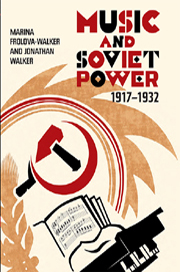Book contents
- Frontmatter
- Contents
- Preface
- Acknowledgements
- Note on transliteration
- Chronology of Political and Musical Events
- October 1917–18: Out of Chaos
- 1919: Depression and Fever
- 1920: Bureaucracy on the Rise
- 1921: Should I stay or should I go?
- 1922: Just Like the Old Days?
- 1923: The Birth of ASM and RAPM
- 1924: ASM in the Ascendant
- 1925: Equilibrium
- 1926: Guests from the West
- 1927: Celebrations
- 1928: At the Crossroads
- 1929: Velikiy perelom – The Great Turning Point
- 1930: RAPM's Glorious Year?
- 1931: RAPM's Fortunes Turning
- 1932: The Rules Change
- Key to Acronyms and Institutional Bodies
- Glossary of Names
- Bibliography
- Index
1924: ASM in the Ascendant
Published online by Cambridge University Press: 05 April 2013
- Frontmatter
- Contents
- Preface
- Acknowledgements
- Note on transliteration
- Chronology of Political and Musical Events
- October 1917–18: Out of Chaos
- 1919: Depression and Fever
- 1920: Bureaucracy on the Rise
- 1921: Should I stay or should I go?
- 1922: Just Like the Old Days?
- 1923: The Birth of ASM and RAPM
- 1924: ASM in the Ascendant
- 1925: Equilibrium
- 1926: Guests from the West
- 1927: Celebrations
- 1928: At the Crossroads
- 1929: Velikiy perelom – The Great Turning Point
- 1930: RAPM's Glorious Year?
- 1931: RAPM's Fortunes Turning
- 1932: The Rules Change
- Key to Acronyms and Institutional Bodies
- Glossary of Names
- Bibliography
- Index
Summary
Lenin's death in January 1924, among other things, led to a new element of Soviet culture that would remain in place until the collapse of the state in 1991. Although Lenin had become increasingly hostile towards Stalin in his final year, the latter became the chief promoter of a cult of personality that endlessly churned out Lenin imagery and slogans, like a magic porridge pot. While appeals to the future continued as before, Soviet citizens were also now expected to look back to Lenin, and measure everything by his example, or rather by that of the sentimental mythology that soon began to accrue. Musicians were quick to offer their tributes. Lenin's supposedly favourite revolutionary song ‘Zamuchen tyazhyoloy nevoley’ (Exhausted by Harsh Imprisonment) was arranged by Lev Shulgin (one of RAPM's founders) three days after Lenin's death, submitted to the engravers on the same day, then proofread and printed that night; the State Cappella began rehearsing it the next morning so that it would be ready for performance at the funeral. A spate of Lenin pieces followed, largely funereal in character, including Kastalsky's ‘At the Coffin’, for reciter and piano, but some were cheerful, like Grigory Lobachev's ‘The Fighting Lenin Song’ (Boyevaya Leninskaya) and ‘Ilyich Lives’ (Zhiv Il'yich).
- Type
- Chapter
- Information
- Music and Soviet Power, 1917–1932 , pp. 100 - 131Publisher: Boydell & BrewerPrint publication year: 2012

